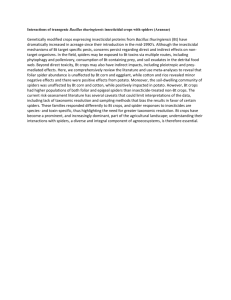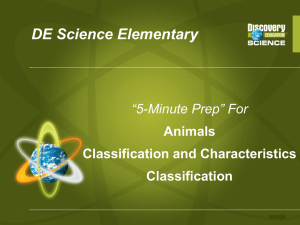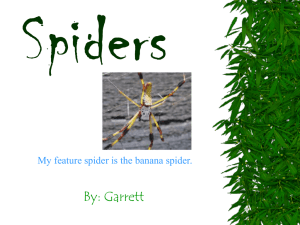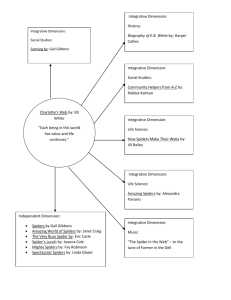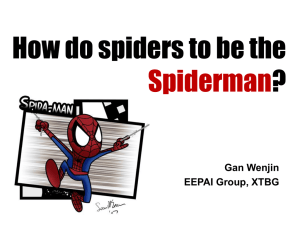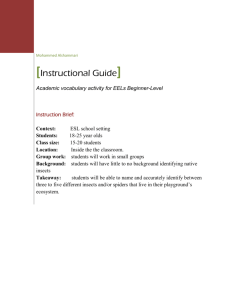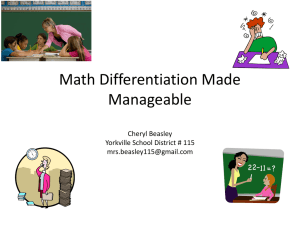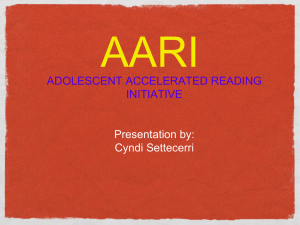Spiders - Achieve the Core
advertisement
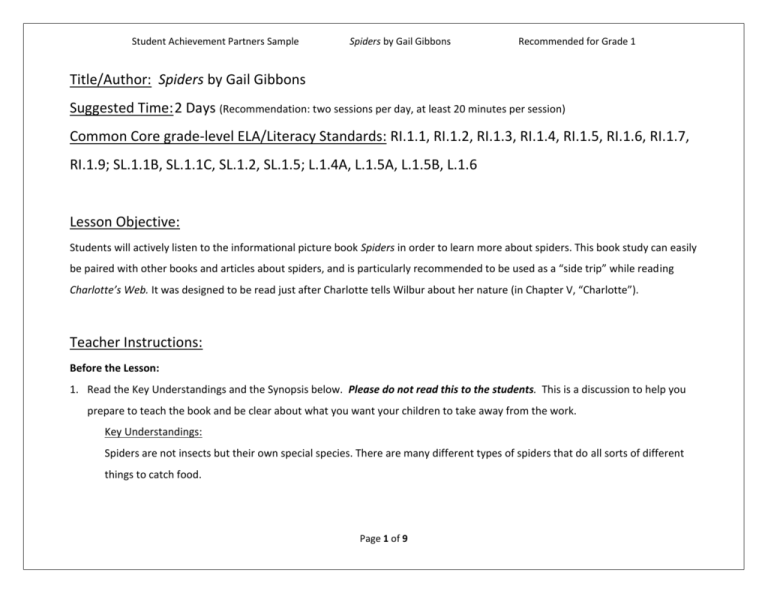
Student Achievement Partners Sample Spiders by Gail Gibbons Recommended for Grade 1 Title/Author: Spiders by Gail Gibbons Suggested Time: 2 Days (Recommendation: two sessions per day, at least 20 minutes per session) Common Core grade-level ELA/Literacy Standards: RI.1.1, RI.1.2, RI.1.3, RI.1.4, RI.1.5, RI.1.6, RI.1.7, RI.1.9; SL.1.1B, SL.1.1C, SL.1.2, SL.1.5; L.1.4A, L.1.5A, L.1.5B, L.1.6 Lesson Objective: Students will actively listen to the informational picture book Spiders in order to learn more about spiders. This book study can easily be paired with other books and articles about spiders, and is particularly recommended to be used as a “side trip” while reading Charlotte’s Web. It was designed to be read just after Charlotte tells Wilbur about her nature (in Chapter V, “Charlotte”). Teacher Instructions: Before the Lesson: 1. Read the Key Understandings and the Synopsis below. Please do not read this to the students. This is a discussion to help you prepare to teach the book and be clear about what you want your children to take away from the work. Key Understandings: Spiders are not insects but their own special species. There are many different types of spiders that do all sorts of different things to catch food. Page 1 of 9 Student Achievement Partners Sample Spiders by Gail Gibbons Recommended for Grade 1 (If connecting to Charlotte’s Web: what Charlotte teaches Wilbur about spiders, and what Wilbur will see for himself at the end, are true facts.) Synopsis: The book starts with general facts about spiders, including where the scientific name of spiders comes from, then tells the parts of a spider’s body and how spiders and insects are different. Then Gibbons gives examples of various interesting spiders and what they do to catch insects to eat. (Note: Charlotte was a common house, or barn, spider). 2. Go to the last page of the lesson and review “What Makes this Read-Aloud Complex.” This was created for you as part of the lesson and will give you guidance about what the lesson writers saw as the sources of complexity or key access points for this book. You will of course evaluate text complexity with your own students in mind, and make adjustments to the lesson pacing and even the suggested activities and questions. 3. Read the entire book, adding your own insights to the understandings identified. Also note the stopping points for the textinspired questions and activities. Note: you may want to copy the questions, vocabulary words, and activities over onto sticky notes so they can be stuck to the right pages for each day’s questions and vocabulary work. Page 2 of 9 Student Achievement Partners Sample Spiders by Gail Gibbons Recommended for Grade 1 The Lesson – Questions, Activities, Vocabulary, and Tasks: The majority of questions, activities, and tasks should be based on the writing, pictures and features unique to Spiders (they should be text-specific). Questions that address text-to-self or text-to-world connections - what we like to call text-inspired questions or activities - should be held until after the children have really gotten to know the book. This lesson is designed to be flexible. Feel free to insert or delete rows as needed for additional questions, activities, or tasks. Questions, Activities, Vocabulary, and Tasks are all aligned to the CCSS for ELA and can address any of the following through reading aloud rich selections: Academic language exploration and learning (vocabulary and syntax) Speaking and Listening activities Writing activities Language activities and questions Creative performance tasks and activities that are text-specific or text-inspired Foundational reading skills reinforcement where appropriate Questions, Activities, Vocabulary, and Tasks FIRST READING: Expected Outcome or Response (for each) Read aloud the entire Spiders book with minimal interruptions. Stop to provide word meanings or clarify only when you know the majority of your students will be confused. SECOND READING: The goal here is for students to enjoy the book, both writing and pictures, and to experience it as a whole. As you read this time, stop and ask clarifying questions and discuss as much of the vocabulary as you can while maintaining some flow. See the vocabulary chart (below) for reference. There will be other opportunities to work on vocabulary. Page 3 of 9 Student Achievement Partners Sample Spiders by Gail Gibbons 1. What sizes do spiders come in? 2. Linger on the pages that compare a spider’s body to an insect’s body. Have the students point to all different sizes and types of print on these pages. 3. Read the big titles again. What do they tell us we will be learning on these pages? 4. What does all the writing on the blue parts of the pages tell us? 5. Tell the children that the writing on the bottom has the BIG idea from these pages. What is it? Have a couple of the students say. 6. Charlotte’s Web connection: Two pages later, the book tells us that baby spiders are called “spiderlings”. Do we know any other baby animals that have –ling in their name? 7. Why do spiders weave webs? 8. What do spiders eat? THIRD READING: Just reread the part of Spiders that tells the different ways spiders make food. Make a chart on chart paper and draw AND list the different kinds of webs and traps the book mentions. Don’t worry about the different names of the spiders. Recommended for Grade 1 1. Students should be able to say they come in all sizes and shapes. Some big (discuss “dinner plates”) and some very small (discuss a “speck of dust”) 2. Students should have a chance to point. 3. They tell us about a spider’s body and an insect’s body and the differences. 4. They are the names for all the different body parts. (Reassure the children they don’t need to remember all of these. Make sure you point out the “spinnerets” since the rest of the book will talk about spinning webs and catching food.) 5. The big idea is that spiders are NOT insects. They are very different. 6. Charlotte’s Web mentions that the goose is expecting goslings, baby geese. 7. To catch their food. 8. They eat insects. This is an inference that is not so easy! So let your students work through it and make sure those who get the answer provide the textual evidence for how they figured this out so all the kids can hear it! The chart should have all of the types listed below. Kids should be encouraged to summarize in their own words after you read each page that tells a type of food catching system. Types of webs: tangled, sheet, funnel, triangle, and orb Types of other traps: hiding in rocks, making a trap door in the ground, hiding in an underwater bell web, changing colors, and hiding in flowers Page 4 of 9 Student Achievement Partners Sample Spiders by Gail Gibbons Recommended for Grade 1 Final Day with the Book - Culminating Task: Charlotte’s Web connection: reread chapter five “Charlotte” where Charlotte teaches Wilbur about her nature as a spider. Have the children notice and talk about the things Charlotte tells Wilbur that were also part of the Spiders book. At the end of Charlotte’s Web, when Charlotte’s children hatch, there will be more connections to make back to this book. If you are doing a standalone unit on spiders, there are other activities to choose from in the Fun Extension Activities. Vocabulary: These words merit less time and attention These words merit more time and attention (They are concrete and easy to explain, or describe events/ processes/ideas/concepts/experiences that are familiar to your students) (They are abstract, have multiple meanings, and/or are a part of a large family of words with related meanings. These words are likely to describe events, ideas, processes or experiences that most of your student will be unfamiliar with) 1st page: 2nd page: 4th page: 5th page: 30,000 – a lot of spiders! speck – a tiny dot, smaller than a pencil mark 300 million years ago – before dinosaurs as Gibbons says, and WAY before people roamed – wandered around, like on a playground when you can’t decide what you want to do legend – an old story that probably isn’t true weaving/weave/weavers – like knitting. Putting strings together in a pattern to make clothes 6th page: spin – to make a string from a clump of something; weavers spin yarn from sheep’s wool on a spinning wheel; spiders spin silk threads from their bodies Page 5 of 9 Student Achievement Partners Sample Spiders by Gail Gibbons These words merit less time and attention 8th page: 9th page: 11th page: 12th page: 14th page: 16th page: 17th page: Recommended for Grade 1 These words merit more time and attention a mate – a partner for a living creature so they can work together to make babies or raise them attract – to make something want to come toward you; a magnet can attract metal encloses – closes them up inside creep – to crawl like a baby sheds – to get rid of something tangled – in knots, with no pattern or design to it held in place – it can’t move much; it is solidly fastened like a seat belt holds people riding in cars pattern – a design that you can see repeating orb – a circle or wheel shape; the earth makes an orbit around the sun; it circles the sun instantly – right away! with no waiting pounces – jumps on; like a cat jumps on a mouse stuns – stings it so it can’t move 18th page: 20th page: burrows – small caves or holes that something has dug protect – keep safe, not let it get hurt hinged – fastened at one end, but so it can swing back and forth; doors have hinges scurries – hurries out; crawls really fast 19th page: Page 6 of 9 unusual – not seen or done very much, not common or usual; in school, you have lunch every day; it is usual; but to have a party in school is not usual; it is unusual; un means “not” Student Achievement Partners Sample Spiders by Gail Gibbons These words merit less time and attention 21st page: 22nd page: 23rd page: Recommended for Grade 1 These words merit more time and attention snatches – grabs quickly disturbed – bothered by something dangerous/danger – can hurt you or kill you poison – something that makes you very sick or even kills you; poison is dangerous! stretched out – pulled so it is as long as it can be can measure – can be as long as 24th page: enemies – something that wants to hurt you, not your friend Last page: expert – someone who knows all about something mashed – all ground up together, squished remedy – a cure or fix for something terrified – very very scared 26th page: important – very special and worth a lot Last page: common – very usual; the opposite of unusual Fun extension activities for Spiders and other useful resources: 1. This read-aloud lesson on spiders was designed as a companion lesson to reading aloud the great classic Charlotte’s Web. We strongly recommend reading Charlotte’s Web aloud as early in first grade as you want to, since many children on track in reading for the CCSS will be able to read Charlotte’s Web for themselves at some point in 3rd grade. Returning to a book you remember fondly is a great prescription for creating lifelong lovers of reading. “Spinning off” Charlotte’s own description of herself when she first meets Wilbur (in chapter V, “Charlotte”) to teach children even more about the wonderful powers of spiders is a great chance to build knowledge systematically. Page 7 of 9 Student Achievement Partners Sample Spiders by Gail Gibbons Recommended for Grade 1 2. Focus on trap door spiders: The BBC website has great videos on this topic. This link will take you to a page on trapdoor spiders with an action video. There are also links to all sorts of other animal adaptations. An activity to teach about hinges and trapdoor spiders: give your children apples for a snack. Have them take as big a bites as they can of the apple (hopefully, you’re reading this to children who still have their front teeth), but not bite completely through the skin. This will leave the bite still connected to the apple by a flap of skin. The bitten piece of apple will flap perfectly against the apple, exactly mimicking the action of a trapdoor. 3. Read aloud other books where spiders are the main characters. See the companion RAP lesson on “The Spider and the Fly” or read more readily available science books. 4. Read D’Aulaire’s version of the myth of Arachne and Athena and their great weaving contest (or any public domain version of the myth you like. If you want to do an activity afterwards to demonstrate weaving with your students, here are easy-tofollow instructions. Instructions on paper weaving Note to Teacher: This book provides solid information, and that is about it. So the questions were designed to move you and your students through to gain maximum information about spiders and what their characteristics are. It is very good to demonstrate text structure and all the different ways a reader gets information from a page. So be sure to emphasize that! But don’t worry about spending a ton of time inside the book. Whenever it is the case that a book is good, but not fabulous, make lemonade out of the lemon! There is tons of vocabulary to work on with your students, and there are useful and educational extension activities you can do with your students laid out just above. Page 8 of 9 Student Achievement Partners Sample Spiders by Gail Gibbons Recommended for Grade 1 What Makes This Read-Aloud Complex? 1. Quantitative Measure Go to http://www.lexile.com/ and enter the title of your read-aloud in the Quick Book Search in the upper right of home page. Most texts will have a Lexile measure in this database. 620 Lexile Most of the texts that we read aloud in K-2 should be in the 2-3 or 4-5 band, more complex than the students can read themselves. 2-3 band 420-820L 4-5 band 740-1010L 2. Qualitative Features Consider the four dimensions of text complexity below. Simple purpose. The book is intended to provide some high interest facts about spiders. Meaning/Purpose Language The language is straightforward. Most sentences are declarative. There is a lot of specialized vocabulary, but Gibbons does a good job supporting it in every case. Highly complex, and worth a good deal of focus. Information comes from pictures (sometimes charts), captions and paragraphs of text. The book goes from general facts about spiders to very specific details about one type of spider. The pages that demonstrate the difference in body types between spiders and insects provide good examples of the complex structure. Structure Knowledge Demands There are lots of big numbers that 1st graders are not likely to know (30 thousand types of spiders, that they’ve been around 300 million years). These should be explained and not glossed over. The idea that animals are grouped into types (spiders and insects) and that they have fancy names (arachnid family) will be news to many children. 3. Reader and Task Considerations What will challenge my students most in this text? What supports can I provide? That the book moves from broad to specific needs to be pointed out and discussed. This is a fairly abstract idea, but there are good examples from the book to make it more concrete. The fact that information comes from the pictures themselves, from the captions and also from the paragraphs at the bottoms is hugely important for kids, even non-readers, to see for themselves. How will this text help my students build knowledge about the world? It will teach them about spiders and their place in the natural world and will give them important experience with complex informational text structure. 4. Grade level: Suitable for 1st grade read-aloud as part of a unit on spiders or as a companion to the reading aloud of Charlotte’s Web *For more information on the qualitative dimensions of text complexity, visit http://www.achievethecore.org/content/upload/Companion_to_Qualitative_Scale_Features_Explained.pdf
